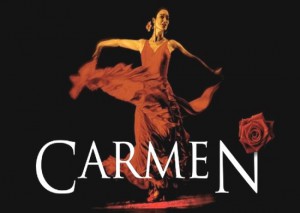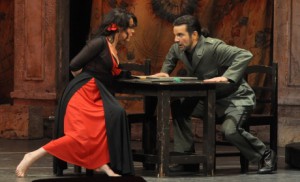A Light Heroine of a Heavy Opera
A Light Heroine of a Heavy Opera
The idea of eternal return is a mysterious one, and Nietzsche has often perplexed other
philosophers with it: to think that everything recurs as we once experienced it, and that
the recurrence itself recurs ad infinitum! What does this mad myth signify?
In the world of eternal return the weight of unbearable responsibility lies heavy on every move we make. That is why Nietzsche called the idea of eternal return the heaviest of burdens (das
schwerste Gewicht).
If eternal return is the heaviest of burdens, then our lives can stand out against it in all
their splendid lightness.
But is heaviness truly deplorable and lightness splendid?
The heaviest of burdens crushes us, we sink beneath it, it pins us to the ground. But in the love poetry of every age, the woman longs to be weighed down by the man’s body. The heaviest of burdens is therefore simultaneously an image of life's most intense fulfillment. The heavier the burden, the closer our lives come to the earth, the more real and truthful they become.
Conversely, the absolute absence of a burden causes man to be lighter than air, to soar into the heights, take leave of the earth and his earthly being, and become only half real, his movements as free as they are insignificant.
What then shall we choose? Weight or lightness?
(Milan Kundera, The unbearable lightness of being)
Opera is thought to be the highest form of “high” performing art by many people; they also suppose that opera is not for everyday people of common education since it is a heavy genre. There are other opinions by different people according to which there is nothing adorable when, on the stage, fat women squeal in a completely incomprehensible language and the opera usually has clumsy or idiotic plots. It is also widely believed that only snobs go to the opera. Here we have two extremely stereotypic opinions about the opera. All stereotypes have some truth—this is why they are believable—but these are simplistic and schematized views with which thinkers must never agree regardless how much attractive they are; the cause of their attractiveness is obvious as it aims at easing one from the heavy burden of thinking.
One warm evening at the beginning of summer, I went to a light entertainment whose place happened to be the Hungarian State Opera House and Carmen was performed that night. It is well-known and proved with surveys of sociologists that Carmen is the most popular opera all over the world. Poor George Bizet! He was not lucky enough to be alive when his last opera, Carmen, became a worldwide success because he passed away three months after its first performance in Opéra Comique, Paris, in 1875. Carmen at that time was received rather coldly and by the end of the season, Opéra Comique dispensed free tickets in order to maintain the minimal interest towards the opera. That year Bizet could not surmise the fact that he had composed the opera which was to become the most popular one all over the world. At the Budapest performance I met an old acquaintance of mine, who happens to be an opera lover and a secondary school teacher. I immediately realized that he arrived at the Opera House together with a dozen teenagers; when we talked to each other, he told me that he brought his class to the performance of Carmen because, as he put is, “it is a popular, easily digestible, melodious opera thus the ideal choice to make the genre popular among young people.” That’s it! – I thought to myself; my acquaintance considers Carmen as a popular opera, easily digestible, that is, light.

My friends know that in my idiolect I humorously call opera “popular music;” when I say “I am listening to popular music,” they know that it means in my case that actually, I am listening to an opera. I mean by all this that it is much easier to receive an opera—having a plot which is able to be described in language—than a “heavy” symphony or a concerto or a sonata. I still believe that these above mentioned forms of music do have “dramaturgies,” they can be even explicated with the means of narratology, but such analyses are rather complicated and they do not lend themselves to analyse as easily as a plot of an opera.
After the fall of Carmen in Paris in 1875, its success and also its popularity began the same autumn at its performance in Vienna; unfortunately, the composer could not enjoy the success of his last opera because he died one day after signing the contract with the Vienna Opera House. It seems to be plausible that the audiences of the imperial city had already been used to contemporary “popular music” and they believed that they saw a light operetta during the performance of Carmen.
The plot of the opera takes place in Seville, around 1820. The beautiful Carmencita desired by many men is a temperamental and fiery gipsy girl, who seduces Don José, a naïve corporal. The soldier abandons his former sweetheart, Michaela, and also the army, then follows the gipsy girl. For the sake of Carmen’s love, Don José even joins a smuggler gang where the girl is on the go, too. After all these, José gets to know that Carmen does not love him anymore but another man, Escamillo, the celebrated toreador, and then, in his jealous fury, stabs Carmen to death.
Carmen has become popular; most of its tunes became hits as all the world and his wife know at least one or two parts of it, like the Habanera, the Seguedilla, the solders’ chorus, the toreador song can be heard in various adaptations; even the ones are familiar with the above mentioned tunes who think they had never heard opera in their lives. The composer had a lively, vigorous plot and he also added all the theatrical details of the French grand opera; furthermore, he supplemented it with a great deal of Spanish exoticism, thus creating a French-Spanish, or, as you like, a Spanish-French opera. Seville, fiery wines, coquetry, love triangle, jealousy, infidelity, beautiful girls, a crackerjack corporal, corrida, torero, children playing army, cartomancy, that is, a couleur locale mixed from Hispanic culture and gipsy romanticism – these are the main parts of the “light” opera with the jill-flirt gipsy girl in the main role.

Carmencita might be a wanton, but the question arises whether she is a light character. Or rather, is her lightness not the burden which pulls her down as the gravity of a weight and thus will her lightness not be her fate? The role of Carmen is the dream of mezzo-sopranos or contraltos; in the genre of the opera, much fewer roles have been composed for mezzos than for sopranos but apart from this fact, to impersonate the character of Carmen is a demanding challenge since it must be sung, also danced, as well as acted out. From the respect of singing, it is rather difficult to sing the role of Carmen; the contralto or mezzo-soprano singer must have the same quality of both high and low sounds, she must also have good ability to sing coloraturas, sing lyrically, and also should have a heavily dramatic sound. Excellent dancing is also a must for a good Carmen; the better she dances the better she impersonates and enchants the audience. Besides various Spanish dances the movements of seduction, hip rocking, and coquettish gestures make up the parts of Carmen’s inevitable toolbar. Above all these, Carmen not only impersonates but also performs the role assigned to her; I am not talking about the singer who impersonates the role but about Carmen who performs it. It is worth taking a closer look at what one should understand by performativity.
Carmen is a manifold transgressor; she hurts gender, sexual, and societal norms. The composer introduces the innovation through Carmen’s character, with which he breaks away with the clichéd traditions of French grand opera, according to which the genre can be characterised either as comic or tragic opera; Carmen has a comical plot but comes to a tragic end. Furthermore, it is also Carmen’s character with which Bizet anticipates the category, which later in Italy will develop to become verismo (realism), where, instead of idealised or abstracted heroes and heroines, he represents—without idealisation—the everyday lives of flesh and blood people living on the edge of society. Carmen may be regarded as a manifold transgressor because she is a gipsy girl; her transgression is primarily racial and this is the very reason for her other transgressions. Race, gender, and sexuality, as poststructuralist theoreticians have pointed out, are social constructions without any ontological essence, that is, they lack any essentialism in the Aristotelian sense. According to the Queer Theory of Judith Butler, the above mentioned categories are performed, that is, day by day we perform them, and for these performances society offers ready-made scripts and tools of the categories of “femininity” or “masculinity,” etc. as prescribed by the norms of society.
Carmen’s tools spring not only from her role of the seductive woman but also from her being a gipsy. She is the unrestrainable proud beast, the free and autonomous being for whom a man cannot give orders and it is she who choses her male partners. For her, love is merely a game, a high-flier bird, and her norms do not fit into the norms of society since it is she, not society, that creates her own rules. She is a self-determined being, who allures men and everything she wants, but when she does not need these any longer, she throws them away. Her character is further shaded by all the myriads of stereotypes which are attached to gypsies, especially to female gypsies. Nevertheless, Carmen playacts the stereotypes and turns them into her own goals thus all her life is theatre where she writes, determines, stage-directs, and performs her role. As an uneducated gipsy girl living on the edge of society, where she is just on the sufferance, is a craftsperson of acting; she must perform all the roles that are prescribed by the racial stereotypes attached to her. She thinks to herself, “if I am a gipsy, I will behave as a stereotypical ‘gipsy girl’ and I will try to live up my minority status in a positive way.” One of the positive attribute of the tobacco-worker living on the bottom-line of society is that she is beautiful, enchantingly beautiful, in the eyes of men she may be apt to become a whore but never an honourable wife. Because of this, Carmen allures men for her own entertainment and pleasure – subverting traditional gender roles according to which the object of sexual desire is the women in heterosexual context, never the man since it is the man who desires, gazes, chooses, and allures the woman.
Carmen displays her being gipsy with her clothes, her singing, dancing, and cartomancy; in the first act, however, it is obvious that she is discriminated based upon her race. There is an incident in the tobacco-factory but it never turns out unequivocally who started the brawl; some say that it was Mañuelita scrapped first, other eyewitnesses claim that Carmen began the fight. One cannot be sure who provoked the quarrel but one thing is sure; it is Carmen who is accused of the incident and she is expected to give and explanation whereas Mañuelita is not held responsible. The logic behind this is if there is a squabble, it must be the gipsy to have started it.
Carmen’s answer to the accusations is that she ridicules her interrogator and breaks out into song:
CARMEN:
Tralalalala,
cut me, burn me,
I shall tell you nothing;
tralalala,
I defy everything -
fire, the sword, and heaven itself!
If she is suspected to have committed crime, the interrogator thinks that only Carmen must be the culprit, and she knows this well. She is treated as a gipsy and her reaction is also that of a gipsy, that is, she mocks the officer of order, even seduces her guard while in detention and with his help, she escapes together with him.
Carmen’s dramaturgical and musical counterpoint is the character of Michaela. She is the well-educated Spanish (not gipsy) girl, who fulfils the request of Don José’s mother; she is a girl of all heart and soul as well as an amiably charming lyric soprano. The tone of her voice is in opposition of Carmen’s lyric, coloratura, and also dramatic contralto that is sometimes demonic. Michaela represents “honourable” society, who tries to reclaim Don José three times, while her behaviour is “normal,” that is, normative, comme il faut. Her dainty, ethereal, and light lyric soprano voice is all but Carmen. Before the spectator or listener begins to feel pity for the poor, deceived Michaela, one should come to the conclusion that her character is so flat, that she seems to be boring. The man who has already been bruised by the light-hearted Carmen with a heavy personality, cannot simply return either to Michaela or to the societal norms represented by her character, more precisely, to the traditional, patriarchal constructions of femininity or masculinity.

Escamillo’s masculinity is in the same way constructed as Carmen’s femininity; the masculinity of the triumphant toreador is displayed by his smiting the bull. The celebration of the victory starts with a rhythm of two fourths piece of music invoking paso doble and the famous toreador song along with the toreador chorus can be heard. In Spanish culture, bull-slaughtering is one of the most important symbol of masculinity. We know about Escamillo that he is a celebrated bull-fighting hero but we do not know about him anything else. Carmen falls in love with him knowing that both of them play-act their roles; the man impersonates the toreador, who even thinks that he himself took Carmen as a lover with his masculinity, whereas the girl, despite her unhonoured and low social status, can get the famous star. Their relationship is not based upon love but rather, upon mutual exploitation and this is reason why it cannot develop anywhere. Escamillo, the man having a higher social status could treat Carmen only as a whore but in the opera, quite the contrary happens because Carmen choses Escamillo, that is, she makes him the object of desire, she treats him as a means for her purposes thus she does the same with him as men do with women according to the norms of patriarchal society. Carmen’s subversive behaviour, in the ecstasy of Escamillo’s triumph, does not rise to view for anyone and the dramaturgy of the plot makes it sure that no-one can observe the heroine’s gender transgression.
By this point, Carmen’s coequal partner remains only Don José, who had lost everything the gipsy girl has never possessed, that is, his honour, family, work, military rank, and also his love. Only in his name is he still “Don” but his fortune and respectability is over because he fall into the trap of falling in love with Carmen. Actually, his jealousy is not enough motivation for stabbing Carmen to death. According to our interpretation, on the one hand, it is his fury that motivates him but on the other hand, it is also the re-establishment of the construction of his masculinity when he kills the girl. He is furious because she took his senses and everything that was precious for him in life. He cannot stumble back to society as a loser and admit that it was a gipsy girl, being of a much lower social rank, who precipitated him to the deepest bottom of social hierarchy; this would mean him a double disadvantage. He can restore his honour and his masculinity—along with these, also the patriarchal order of the world—by killing Carmen.
Carmen’s character is astonishingly light. The light jill-flirt does not respect anything or anybody, she cannot be tied with handcuffs, nor with love, morals, family – these notions are elusive for her being without any essence. Her lightness turns into light-headedness, which she performs with her series of transgressions. This kind of lightness has a big price because she cannot stay anywhere for long, she cannot take root but neither can she fly off into the ethereal heights because she is a flesh and blood person in the world and she cannot live outside society. Her lightness is burdened onto her like weights when she flirts with death in her aria of cards and she realizes that she cannot escape the dialectics of light/heavy. When she tells her fortunes by cards, one would not believe that she does so just for some gipsy fun like her female friends. She instinctively anticipates how heavy her lightness is and the price of this is her upcoming death. It is not by contingent that she reaches the most dramatic tone in this scene while her female friends, as counterpoints, cheerfully laughing play games with cartomancy. The title heroine of the “light” opera becomes heavier and heavier; by the end, her weight pulls her down to Hades.

Carmen is a “light” opera with its simple and realistic plot, quick events, with its melodious tunes being able to croon easily, with its spectacular scenes and exotic dances and last but not least, with its toolbar of the French grand opera. It is easy to receive and understand. If we thinks over Carmen’s heavy character and we come back—as a Nietzschean eternal recurrence—to the beginning of our train of thoughts, we can think our thoughts over and over again. The heavy works, even if they are seemingly “light,” provoke from the receiver to ask our questions anew. Doing so, as a matter of fact, we construe not only the work but ourselves and our world around us.
What then shall we choose? Weight or lightness?
Parmenides posed this very question in the sixth century before Christ. He saw the world divided into pairs of opposites: light/darkness, fineness/coarseness, warmth/cold, being/non-being. One half of the opposition he called positive (light, fineness, warmth, being), the other negative. We might find this division into positive and negative poles childishly simple except for one difficulty: which one is positive, weight or lightness? (. . .) The only certainty is: the lightness/weight opposition is the most mysterious, most ambiguous of all.
(Milan Kundera, The unbearable lightness of being)



